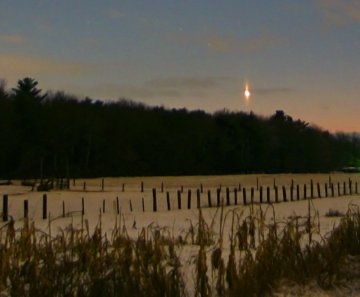 Did you sleep through the auroras of Dec. 14th? Next time get a wake-up call: Spaceweather PHONE.
Did you sleep through the auroras of Dec. 14th? Next time get a wake-up call: Spaceweather PHONE.
SOUTH POLE FLYBY: This week, the ESA-NASA Ulysses spacecraft is flying over uncharted territory--the mysterious South Pole of the sun: full story.
VENUS PILLARS: Venus is so bright, it does things normally reserved for the Sun and Moon--such as sprouting pillars. John E. Cordiale of South Glens Falls, NY, took this picture on Jan. 24th:

Photo details: Canon 350D, Tamron 19-35mm lens, 800 iso, 30 seconds
"I was watching the sunset and noticed that Venus looked a little strange," says Cordiale. "I took some photos and found that Venus had pillars! In one image Venus was behind the clouds and the pillars were still visible."
Venus pillars, like Sun pillars and Moon pillars, are caused by flat, six-sided ice crystals fluttering down from high clouds. The crystals reflect light from their horizontal faces, spreading a single point of light into a luminous column.
Tonight, look for Venus pillars after sunset. And if you don't see any, let Mercury be your consolation prize: sky map.
IN THE FREEZER SECTION: "I always marvel at halos, pillars and sundogs--all made by tiny ice crystals," says photographer Mila Zinkova of San Francisco. "But where could I find these tiny wonders here in San Francisco?" She found these at Costco:

Photo details: Canon XTI, 28 mm lens, macro mode
"In Costco," she explains, "freezer doors are made out of double glass and sometimes ice crystals form in between." Not all beauty is in the sky, it seems. You can find some in the refrigerator section, too.

